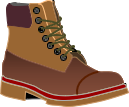4. Error Sources and Behavior
a. Instrumental / Personal
(1) Consistency
(a) Principle
It may take some time for a new surveyor to settle into a comfortable, consistent walking rate.
(b) Behavior
Random
(c) Compensation
Practice and paying attention to other errors
(2) Footgear
(a) Principle
Shoe type, Figure B-4, affects how a person walks.
   |
| Figure B-4 Footgear |
(b) Behavior
Random.
(c) Compensation
Use footgear typically worn in field situations.
(3) Counting
(a) Principle
Forgetting the count as you are pacing can happen, particularly on longer distances.
(b) Behavior
Mistake.
(c) Compensation
Repeat measurements to find and discard mistaken counts.
(4) Individual v Group
(a) Principle
Everyone has their own normal stride. When walking in a group, some individuals speed up, others slow down so the group stays together. This happens subconsciously and will affect pacing.
(b) Behavior
Random.
(c) Compensation
Walk alone.
(5) Self-consciousness
(a) Principle
The key to successful pacing is to maintain a normal comfortable walking rate. Doing something out of the ordinary will affect pacing.
Step off normally when stating a pace (many first-timers exaggerate the initial step).
Don't look down at your feet (you won't leave them behind), instead watch where you're going and to see obstacles.
Use peripheral vision at the end of the pace to avoid stretching or shrinking the last step.
Believe it or not, some people still remember and react to "Step on a crack, break your mother's back." (If you didn't before, you will now as I've planted the seed)
(b) Behavior
Random.
(c) Compensation
Practice.
(6) Computations
(b) Principle and Behavior
Over/understating accuracy, math blunder, etc. Mistake.
(c) Compensation
Care and review.
b. Natural
(1) Terrain
(a) Principle
In Surveying we use horizontal distances; pacing returns a distance along the ground, Figure B-5. On rolling terrain, the paced distance will be too long.
 |
| Figure B-5 Pacing Along the Ground |
(b) Behavior
Random.
(c) Compensation
The only way to compensate is to make an adjustment based on terrain analysis.
(2) Slopes
(a) Principle
Slopes affect walking rate. Going uphill tends to shorten paces, downhill lengthens, Figure B-6.
|
|
| Figure B-6 Slope Effects |
(b) Behavior
Systematic/Random.
(c) Compensation
The only way to compensate is to make an adjustment based on terrain analysis.
(3) Temperature
(a) Principle
We tend to walk more quickly in cold weather than warm which affects pace lengths.
(b) Behavior
Random.
(c) Compensation
Re-calibrate under cold conditions.
